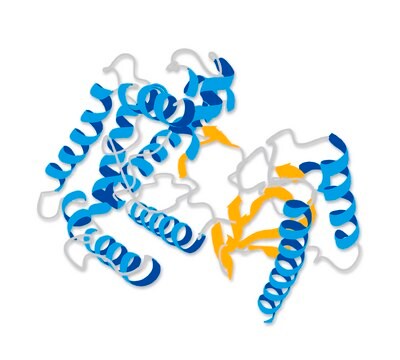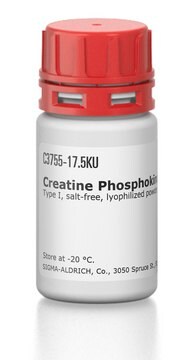M3003
Myokinase from rabbit muscle
ammonium sulfate suspension, 1,500-3,000 units/mg protein (biuret)
Synonym(s):
ATP: AMP phosphotransferase, Adenylate Kinase
Sign Into View Organizational & Contract Pricing
All Photos(1)
About This Item
Recommended Products
biological source
rabbit muscle
Quality Level
form
ammonium sulfate suspension
specific activity
1,500-3,000 units/mg protein (biuret)
mol wt
21 kDa
foreign activity
3-phosphoglyceric phosphokinase ≤0.05%
lactic dehydrogenase and pyruvate kinase ≤0.01%
storage temp.
2-8°C
General description
Research area: Cell Signaling
Myokinase, also called Adenylate kinase or ADK, is a phosphotransferase enzyme. It belongs to the family of nucleoside monophosphate kinases. Myokinase is an enzyme that can be found in skeletal muscle and acts as a phosphotransferase agitator.
Myokinase, also called Adenylate kinase or ADK, is a phosphotransferase enzyme. It belongs to the family of nucleoside monophosphate kinases. Myokinase is an enzyme that can be found in skeletal muscle and acts as a phosphotransferase agitator.
Application
Myokinase has been used:
- in a study to assess its reaction with the mercurials p-hydroxymercuribenzoate and p-mercuribenzenesulfonate
- in a study to investigate the ligand-binding properties of its peptide fragments
- as one of the components in the ATP generation solution for the quantification of 3’3’-c-di-AMP using an AMP-Luciferase assay
Biochem/physiol Actions
Myokinase or adenylate kinases, play a crucial role in regulating energy metabolism within cells and balancing adenine nucleotide ratios in different cellular compartments.
Myokinase is a key enzyme involved with adenine nucleotide metabolism. The action of myokinase insures that the adenine nucleotides (ATP, ADP, and AMP) are maintained in equilibrium in the cytosol.
Myokinase catalyzes the following reaction:ADP + ADP → ATP + AMP
Myokinase is a key enzyme involved with adenine nucleotide metabolism. The action of myokinase insures that the adenine nucleotides (ATP, ADP, and AMP) are maintained in equilibrium in the cytosol.
Myokinase catalyzes the following reaction:ADP + ADP → ATP + AMP
Rabbit muscle myokinase can be inactivated by treatment with dithiobis-(2-nitrobenzoic) acid which alters methionine residues critical to myokinase activity.
Unit Definition
One unit will convert 2.0 μmoles of ADP to ATP+AMP per min at pH 7.6 at 37°C.
Physical form
Suspension in 3.2 M (NH4)2SO4 solution containing 0.001 M EDTA, pH 6.0
Storage Class Code
10 - Combustible liquids
WGK
WGK 3
Flash Point(F)
Not applicable
Flash Point(C)
Not applicable
Personal Protective Equipment
dust mask type N95 (US), Eyeshields, Gloves
Choose from one of the most recent versions:
Already Own This Product?
Find documentation for the products that you have recently purchased in the Document Library.
Customers Also Viewed
Inactivation of rabbit muscle adenosine triphosphate-adenosine 5'-phosphate phosphotransferase by alkylation of methionine residues.
L F Kress et al.
The Journal of biological chemistry, 242(4), 558-564 (1967-02-25)
Secretion from dense granules: luminescence method for adenine nucleotides.
M Fred Heath
Methods in molecular biology (Clifton, N.J.), 272, 89-93 (2004-07-01)
Likui Feng et al.
Nature communications, 12(1), 4912-4912 (2021-08-15)
Polyketide synthase (PKS) and nonribosomal peptide synthetase (NRPS) hybrid systems typically use complex protein-protein interactions to facilitate direct transfer of intermediates between these multimodular megaenzymes. In the canal-associated neurons (CANs) of Caenorhabditis elegans, PKS-1 and NRPS-1 produce the nemamides, the only known
The sulfhydryl groups of rabbit muscle adenosine triphosphate-adenosine monophosphate phosphotransferase. Activity of enzyme treated with mercurials.
L F Kress et al.
The Journal of biological chemistry, 241(10), 2293-2300 (1966-05-25)
S A Kuby et al.
Journal of protein chemistry, 8(4), 549-562 (1989-08-01)
Two peptide fragments, derived from the head and tail of rabbit muscle myokinase, were found to possess remarkable and specific ligand-binding properties (Hamada et al., 1979). By initiating systematic syntheses and measurements of equilibrium substrate-binding properties of these two sets
Articles
Instructions for working with enzymes supplied as ammonium sulfate suspensions
Our team of scientists has experience in all areas of research including Life Science, Material Science, Chemical Synthesis, Chromatography, Analytical and many others.
Contact Technical Service









